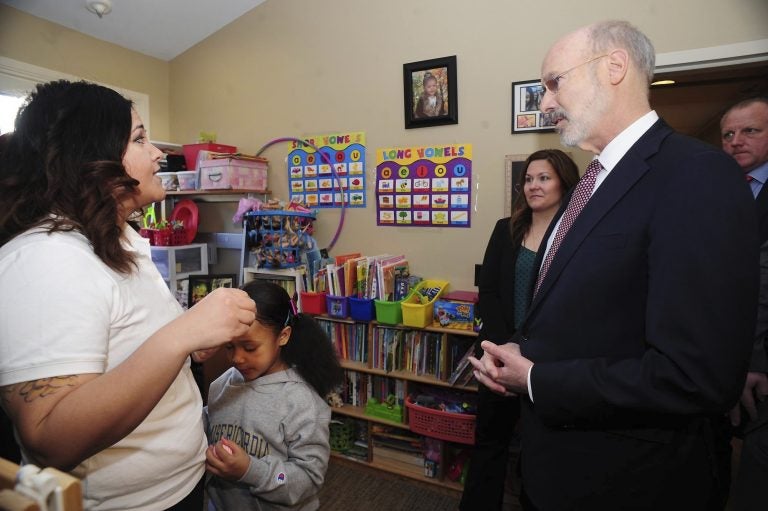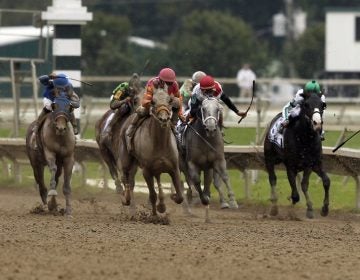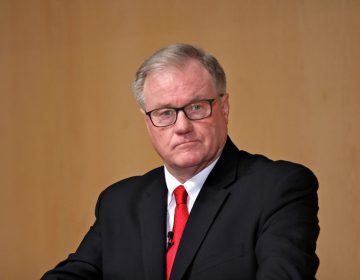Pennsylvania’s school funding fight exits spotlight
For years, Pennsylvania's school-funding system has stuck out nationally, occasionally flagged as one of the least equitable.

Pennsylvania Gov. Tom Wolf talks with Misericordia University student and mother Rochelle Jade Scott and her daughter Sky as he visited Misericordia University in Dallas, Pa., Friday, Feb. 8, 2019, to tour the Ruth Matthews Bourger Women with Children Program and to outline his bold budget plan to create the strongest workforce in the nation. (Mark Moran/The Citizens' Voice via AP)
When Gov. Tom Wolf took office, he told lawmakers that he had a plan to fix Pennsylvania’s system of school funding.
Four years and a couple of budget fights later, public school advocates say huge gaps still persist between poorer and wealthier districts, while the subject didn’t rate a mention this past week in the Democrat’s first budget speech to the Legislature after his re-election.
That prompted grumbling among Democratic lawmakers, although some in the school-funding trenches say Wolf hasn’t necessarily given up. Rather, his silence reflects the difficult politics in the Republican-controlled Legislature, they say.
“I think in this particular budget, coming off of a new election with a Legislature that has been at least semi-productive in the last year or two, that the governor said, ‘Look, I’m not going to stick a fork in anybody’s eye to get started with,'” said Rep. Mike Sturla, D-Lancaster.
For his part, Wolf’s office says he remains open to a discussion with the Legislature on making school funding fairer. However, someone else may have to carry the torch.
For years, Pennsylvania’s school-funding system has stuck out nationally, occasionally flagged as one of the least equitable.
Districts in the top half of average household income spent $673 more per student than districts in the bottom half, according to an Associated Press analysis of 2016-17 state data on school district spending, income and attendance, the latest available.
The gap is wider on the farther ends of the income spectrum: The wealthiest 10 districts spent an average of $4,300 more per student, or more than a quarter above what the poorest 10 districts spent, according to AP’s analysis.
In 2015, Wolf advanced a couple of strategies to tackle those inequities.
He proposed a big increase, $400 million, in state aid for general public school instruction and operations, but it came packaged with a tax increase that didn’t fly with Republicans.
He floated a $3.2 billion tax-shifting plan — cutting property taxes, primarily in poorer districts, and replacing the money with state tax increases — in a bid to boost Pennsylvania’s state share of school funding to 50 percent. It stalled amid a winners-versus-losers debate and calls to completely eliminate school property taxes.
In his new budget plan, Wolf proposed a $200 million increase — the upper limit of what lawmakers approved in Wolf’s first term — and no tax-shifting plan.
Then there are ideas to funnel more of the $6 billion-plus in general state aid through a four-year-old school funding formula. Only a fraction of that aid currently goes through the formula, designed to be fairer by reflecting changes in school district attendance and wealth that budget makers largely ignored for 25 years.
Now, 70 percent of the state’s 500 school districts receive a bigger share of state aid than they would under the updated formula.
But proposals to expand the formula’s use have fallen flat — and became a leading Republican line of attack against Wolf in last year’s campaign — because they create more losing districts than winning districts.
“Certainly you’re not going to solve that problem in a single stroke,” said Rep. James Roebuck, of Philadelphia, the House Education Committee’s ranking Democrat. “We have a budget that’s narrowly balanced between conflicting interests, and I don’t see any way to quickly resolve that issue.”
Inequalities in school funding could be partly due to a quarter-century of herky-jerky formulas.
Meanwhile, the Pennsylvania state government supplies less than 38 percent of total school revenue, according to federal data from 2016, making it 46 out of 50 states. States average 51 percent.
Pennsylvania’s relative imbalance leaves poorer school districts overly reliant on inadequate local tax bases and drives inequities between districts, the system’s critics say.
Dynamics like that are why the parents of six school children, six school districts, the NAACP and a rural schools group are suing the state.
The four-year-old lawsuit is scheduled for trial next year and has sowed concern among Republican lawmakers that the state Supreme Court could order a massive new investment in public schools.
In the meantime, public school advocates are trying to build support for ideas to funnel a bigger share of money to districts that are suffering the most.
Sturla recalled speaking with Wolf days before his budget speech to see if the governor would propose anything like that.
The answer was “no.” But, Wolf told him: “Everything is negotiable.”
WHYY is your source for fact-based, in-depth journalism and information. As a nonprofit organization, we rely on financial support from readers like you. Please give today.



